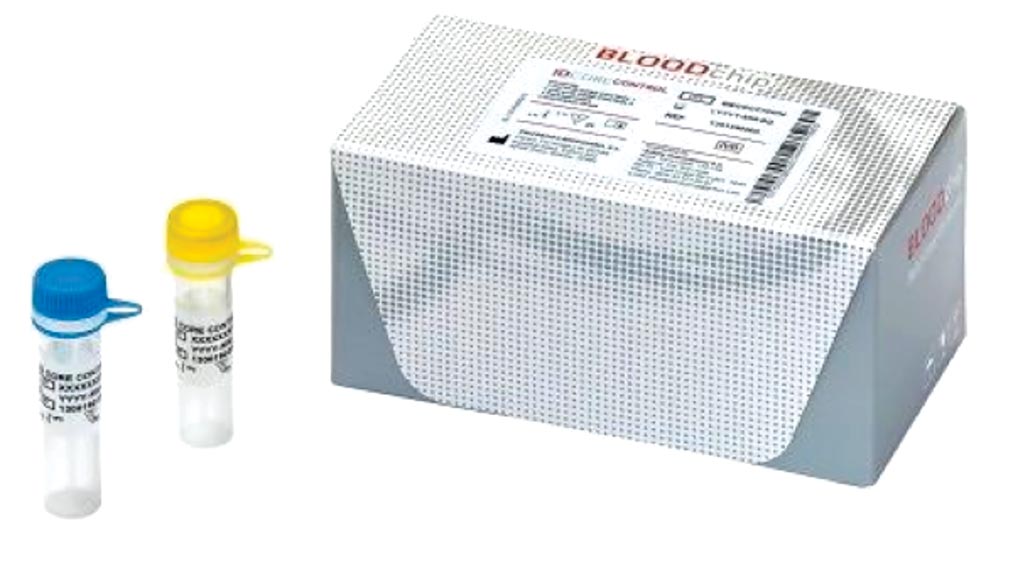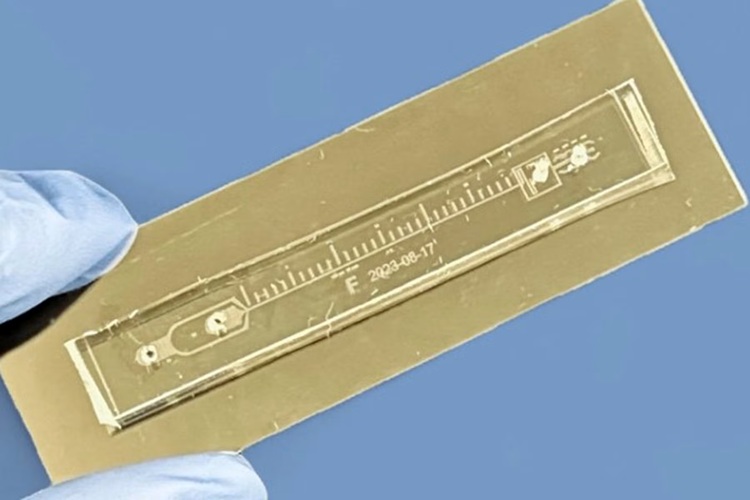Next-Gen Sequencing Matches Blood Group Antigens for Transfusion
|
By LabMedica International staff writers Posted on 26 Sep 2019 |

Image: The ID Core XT BLOODchip is a molecular-based assay used in blood transfusion medicine to help determine blood compatibility and could supplement the classical blood match methodology (Photo courtesy of Progenika Biopharma SA).
Transfusion is the procedure of introducing donor material with unknown blood cell antigens into the recipient’s circulatory system. The recipient’s immune system recognizes foreign antigens, produces specific antibodies and sensitization (alloimmunization) occurs.
To date, more than 300 red blood cell (RBC) and 33 human platelet antigens (HPA) have been described. Extended antigen typing is time-consuming, serological methods are costly and depend on the availability of reagents for antigen detection. The procedure is usually performed in reference laboratories, which complicates and delays the delivery of blood for transfusion.
Scientists at the Institute of Hematology and Transfusion Medicine (Warsaw, Poland) have reviewed the advances in applying next-generation sequencing (NGS) to transfusion medicine for the purpose of genotyping alleles encoding clinically important red blood cell and platelet antigens. The currently available technologies allow various levels of sequencing; either the whole genome (WGS), coding regions, exons (WES) or only selected genes or regions of interest. NGS technology significantly reduces the cost of testing. It has been successfully implemented in transplantation medicine for testing donors’ genotypes of HLA antigens in high-throughput mode. Over 9,000 HLA alleles for over 500 individuals can be identified per run.
NGS is particularly effective for finding unknown variations responsible for different phenotypes in patients with antibodies of unknown specificity because it enables screening of the whole genome, exome or particular genes and finding an unknown or rare variant. Recent studies have confirmed NGS effectiveness in resolving the molecular background of orphan antigens with an as yet unknown genetic basis. NGS is also effective in reducing the risk of post-transfusion alloimmunization since the huge capacity of one investigation enables the immediate and cost-effective determination of all RBC and platelet antigen genotypes. Study results support extended profiling of donors and patients for the best prophylactic antigen matching to prevent alloimmunization.
The application of NGS technology for blood typing contributes to the following aspects of patient care: Prevention of alloimmunization in sickle cell disease (SCD) and other transfusion-dependent patients; faster and cheaper diagnostics in the case of patients with unexplained, complex serological results; the huge capacity of the NGS investigations makes this technology an ideal tool for mass screening of blood donors for all clinically important antigens and also to detect individuals with rare blood group antigens in various ethnic groups; this facilitates access to compatible donors for alloimmunised patients.
The authors concluded that the future of NGS as a supplementary test used to provide highly compatible blood as well as to reduce the risk of patient’s alloimmunization and this is part of personalized medicine. The study was published on September 3, 2019, in the journal International Journal of Clinical Transfusion Medicine.
Related Links:
Institute of Hematology and Transfusion Medicine
To date, more than 300 red blood cell (RBC) and 33 human platelet antigens (HPA) have been described. Extended antigen typing is time-consuming, serological methods are costly and depend on the availability of reagents for antigen detection. The procedure is usually performed in reference laboratories, which complicates and delays the delivery of blood for transfusion.
Scientists at the Institute of Hematology and Transfusion Medicine (Warsaw, Poland) have reviewed the advances in applying next-generation sequencing (NGS) to transfusion medicine for the purpose of genotyping alleles encoding clinically important red blood cell and platelet antigens. The currently available technologies allow various levels of sequencing; either the whole genome (WGS), coding regions, exons (WES) or only selected genes or regions of interest. NGS technology significantly reduces the cost of testing. It has been successfully implemented in transplantation medicine for testing donors’ genotypes of HLA antigens in high-throughput mode. Over 9,000 HLA alleles for over 500 individuals can be identified per run.
NGS is particularly effective for finding unknown variations responsible for different phenotypes in patients with antibodies of unknown specificity because it enables screening of the whole genome, exome or particular genes and finding an unknown or rare variant. Recent studies have confirmed NGS effectiveness in resolving the molecular background of orphan antigens with an as yet unknown genetic basis. NGS is also effective in reducing the risk of post-transfusion alloimmunization since the huge capacity of one investigation enables the immediate and cost-effective determination of all RBC and platelet antigen genotypes. Study results support extended profiling of donors and patients for the best prophylactic antigen matching to prevent alloimmunization.
The application of NGS technology for blood typing contributes to the following aspects of patient care: Prevention of alloimmunization in sickle cell disease (SCD) and other transfusion-dependent patients; faster and cheaper diagnostics in the case of patients with unexplained, complex serological results; the huge capacity of the NGS investigations makes this technology an ideal tool for mass screening of blood donors for all clinically important antigens and also to detect individuals with rare blood group antigens in various ethnic groups; this facilitates access to compatible donors for alloimmunised patients.
The authors concluded that the future of NGS as a supplementary test used to provide highly compatible blood as well as to reduce the risk of patient’s alloimmunization and this is part of personalized medicine. The study was published on September 3, 2019, in the journal International Journal of Clinical Transfusion Medicine.
Related Links:
Institute of Hematology and Transfusion Medicine
Latest Hematology News
- Platelet Activity Blood Test in Middle Age Could Identify Early Alzheimer’s Risk
- Microvesicles Measurement Could Detect Vascular Injury in Sickle Cell Disease Patients
- ADLM’s New Coagulation Testing Guidance to Improve Care for Patients on Blood Thinners
- Viscoelastic Testing Could Improve Treatment of Maternal Hemorrhage
- Pioneering Model Measures Radiation Exposure in Blood for Precise Cancer Treatments
- Platelets Could Improve Early and Minimally Invasive Detection of Cancer
- Portable and Disposable Device Obtains Platelet-Rich Plasma Without Complex Equipment
- Disposable Cartridge-Based Test Delivers Rapid and Accurate CBC Results
- First Point-of-Care Heparin Monitoring Test Provides Results in Under 15 Minutes

- New Scoring System Predicts Risk of Developing Cancer from Common Blood Disorder
- Non-Invasive Prenatal Test for Fetal RhD Status Demonstrates 100% Accuracy
- WBC Count Could Predict Severity of COVID-19 Symptoms
- New Platelet Counting Technology to Help Labs Prevent Diagnosis Errors
- Streamlined Approach to Testing for Heparin-Induced Thrombocytopenia Improves Diagnostic Accuracy
- POC Hemostasis System Could Help Prevent Maternal Deaths
- New Test Assesses Oxygen Delivering Ability of Red Blood Cells by Measuring Their Shape
Channels
Clinical Chemistry
view channel
Chemical Imaging Probe Could Track and Treat Prostate Cancer
Prostate cancer remains a leading cause of illness and death among men, with many patients eventually developing resistance to standard hormone-blocking therapies. These drugs often lose effectiveness... Read more
Mismatch Between Two Common Kidney Function Tests Indicates Serious Health Problems
Creatinine has long been the standard for measuring kidney filtration, while cystatin C — a protein produced by all human cells — has been recommended as a complementary marker because it is influenced... Read moreMolecular Diagnostics
view channel
Urine Test Detects Inherited Neuropathy Missed by Genetic Screening
Sorbitol dehydrogenase (SORD)-related neuropathy is one of the most common inherited nerve disorders, yet diagnosis often lags because current genetic screens frequently miss the causal gene.... Read more
Genomic Test Predicts Risk of SCC Metastasis
Managing squamous cell carcinoma (SCC) of the skin in patients with one or more risk factors is a significant clinical challenge, especially as SCC-related deaths are now estimated to exceed those from melanoma.... Read moreImmunology
view channel
Chip Captures Cancer Cells from Blood to Help Select Right Breast Cancer Treatment
Ductal carcinoma in situ (DCIS) accounts for about a quarter of all breast cancer cases and generally carries a good prognosis. This non-invasive form of the disease may or may not become life-threatening.... Read more
Blood-Based Liquid Biopsy Model Analyzes Immunotherapy Effectiveness
Immunotherapy has revolutionized cancer care by harnessing the immune system to fight tumors, yet predicting who will benefit remains a major challenge. Many patients undergo costly and taxing treatment... Read moreMicrobiology
view channel
Blood-Based Molecular Signatures to Enable Rapid EPTB Diagnosis
Extrapulmonary tuberculosis (EPTB) remains difficult to diagnose and treat because it spreads beyond the lungs and lacks easily accessible biomarkers. Despite TB infecting 10 million people yearly, the... Read more
15-Minute Blood Test Diagnoses Life-Threatening Infections in Children
Distinguishing minor childhood illnesses from potentially life-threatening infections such as sepsis or meningitis remains a major challenge in emergency care. Traditional tests can take hours, leaving... Read more
High-Throughput Enteric Panels Detect Multiple GI Bacterial Infections from Single Stool Swab Sample
Gastrointestinal (GI) infections are among the most common causes of illness worldwide, leading to over 1.7 million deaths annually and placing a heavy burden on healthcare systems. Conventional diagnostic... Read morePathology
view channel
Blood Test and Sputum Analysis Predict Acute COPD Exacerbation
Chronic obstructive pulmonary disease (COPD) remains a major contributor to global illness, largely driven by cigarette smoking and marked by irreversible lung damage. Acute exacerbations can accelerate... Read more
AI Tool to Transform Skin Cancer Detection with Near-Perfect Accuracy
Melanoma continues to be one of the most difficult skin cancers to diagnose because it often resembles harmless moles or benign lesions. Traditional AI tools depend heavily on dermoscopic images alone,... Read more
Unique Immune Signatures Distinguish Rare Autoimmune Condition from Multiple Sclerosis
Myelin oligodendrocyte glycoprotein antibody–associated disease (MOGAD) is a rare autoimmune disorder in which the immune system attacks the myelin sheath in the central nervous system. Although symptoms... Read moreTechnology
view channel
AI Saliva Sensor Enables Early Detection of Head and Neck Cancer
Early detection of head and neck cancer remains difficult because the disease produces few or no symptoms in its earliest stages, and lesions often lie deep within the head or neck, where biopsy or endoscopy... Read more
AI-Powered Biosensor Technology to Enable Breath Test for Lung Cancer Detection
Detecting lung cancer early remains one of the biggest challenges in oncology, largely because current tools are invasive, expensive, or unable to identify the disease in its earliest phases.... Read moreIndustry
view channel
Abbott Acquires Cancer-Screening Company Exact Sciences
Abbott (Abbott Park, IL, USA) has entered into a definitive agreement to acquire Exact Sciences (Madison, WI, USA), enabling it to enter and lead in fast-growing cancer diagnostics segments.... Read more
























